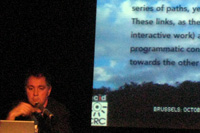Deleuze vs. YouTube: Adrian Miles @ Video Vortex
 The subtitle of this conference is Responses to YouTube, and at least one alternative to the world’s largest supplier of piano-playing-cat videos comes in the form of ‘soft video’, via Australian media scholar Adrian Miles.
The subtitle of this conference is Responses to YouTube, and at least one alternative to the world’s largest supplier of piano-playing-cat videos comes in the form of ‘soft video’, via Australian media scholar Adrian Miles.
Some of the questions he asks: Where does an online video end – at what point is it ‘complete’? Are those limits imposed by technology or are they lingering clichés of narrative form (as opposed to Manovich’s ‘database’)? Can online video be imagined differently, outside the frames of cinema and TV?
Television Killed the Video Star
The problem with web video now is that it is not television but acts as if it is. YouTube aligns itself with some aspects of TV: it doesn’t allow users to manipulate content, and owns content generated by users. Its affinity with TV is made most obvious by the fact that the site centers around popular TV content (making its biggest problem copyright laws).
On the other hand, Miles says, YouTube helps de-naturalize some industry assumptions about ‘quality’ TV – what good is high resolution version of the Colbert Report if everyone is watching it online anyway? It also promotes dynamic pathways through content, and merely by being popular it contributes to the development of Web video standards (not necessarily a bad thing).
Actualizing the Virtual with Soft Video
Adopting the language of Gilles Deleuze, Miles makes the case for rethinking video. He says that if YouTube is to survive, it will have to make its content granular: tagging scenes and shots, linking between them, making it easy to remix content at the level of the smallest possible unit.
By opening up video – through both industry decisions and by building better remix software – a space opens up for what Miles calls soft video. This would be a move away from what he calls teleological editing – that bane of narrative form that says you need a third act, a fitting conclusion. Rather, following the database form of the Web, online video could become something new (there is no ‘last page’ on the Internet, Miles jokes). The aesthetics of soft video would be less those of cinema or televison, and more those of music: rhythm and repetition, feel and tone. Soft video would not be shaped by a need for closure, and every movement ‘forward’ would open up new trajectories rather than shut them down. Soft video would actualize the virtual.